二十年来,在糖尿病研究中将性别视为一个生物变量
IF 4.9
2区 医学
Q1 ENDOCRINOLOGY & METABOLISM
引用次数: 0
摘要
1 型和 2 型糖尿病的发病风险以及糖尿病相关并发症的发病风险存在性别差异。葡萄糖稳态、胰岛和β细胞生物学以及外周胰岛素敏感性方面的性别差异也有报道。然而,我们缺乏有关这些差异的详细机制信息,因此无法为糖尿病患者制定基于性别的治疗策略。要想在糖尿病研究中更多地考虑生理性别这一变量,我们首先需要对该领域的常见做法进行详细评估。我们开发了一套评分系统,用于评估在《糖尿病》(美国糖尿病协会出版的期刊)上发表的稿件中纳入生物性别的情况。我们之所以选择《糖尿病》,是因为该杂志只关注糖尿病和糖尿病相关研究,并收录了采用临床和生物医学方法的稿件。我们对 20 年内(1999 年、2009 年、2019 年)发表的 3 年论文进行了评分,这一时间段跨越了资助机构和期刊政策出台的时间,这些政策旨在改善对生理性别这一变量的考虑。我们的分析表明,在所有研究年份中,只有不到15%的论文在哪怕一个图表中使用了基于性别的分析,这一趋势在期刊定义的糖尿病研究类别(如胰岛研究、信号转导)中也有体现。单一性别研究约占所有稿件的 40%,其中大于 87% 的研究仅使用男性受试者。在我们的研究期间,虽然我们观察到将性别作为生物变量纳入研究的总体情况略有增加,但我们的数据凸显了改进糖尿病研究实践的重要机会。我们还提供数据支持期刊政策在促进糖尿病研究更好地考虑生物性别方面的积极作用。我们的分析提供了有关糖尿病研究中将生理性别作为变量的常见做法的重要见解。根据我们的分析,我们建议糖尿病研究人员如何改进将生理性别作为变量的做法。从长远来看,改进后的研究方法将揭示糖尿病风险和并发症的性别特异性机制,为制定以性别为基础的预防和治疗策略提供知识。男性和女性患 1 型和 2 型糖尿病的风险不同。男女患糖尿病并发症的情况也不同,治疗效果也不同。造成这些差异的原因之一是生理性别会影响糖尿病风险、并发症和治疗效果。遗憾的是,很多糖尿病研究并没有考虑生理性别是否会影响研究结果。因此,我们没有足够的信息来根据个人的性别制定最佳的糖尿病预防和治疗策略。我们正在通过了解糖尿病研究人员如何在研究中考虑生理性别来解决这个问题。我们阅读了 800 多篇糖尿病研究论文并进行了评分,以了解他们在研究中是否考虑了生理性别以及考虑得如何。根据我们的结果,我们推荐了几种简便的方法,让糖尿病研究人员在工作中更好地考虑生理性别。随着越来越多的研究人员考虑生理性别,他们将更多地了解个人性别对糖尿病风险、并发症和治疗效果的影响。这些信息将使整个糖尿病界受益,因为它代表了将个人性别与最佳预防和治疗策略相匹配的第一步。本文章由计算机程序翻译,如有差异,请以英文原文为准。
Consideration of sex as a biological variable in diabetes research across twenty years
Sex differences exist in the risk of developing type 1 and type 2 diabetes, and in the risk of developing diabetes-associated complications. Sex differences in glucose homeostasis, islet and β cell biology, and peripheral insulin sensitivity have also been reported. Yet, we lack detailed information on the mechanisms underlying these differences, preventing the development of sex-informed therapeutic strategies for persons living with diabetes. To chart a path toward greater inclusion of biological sex as a variable in diabetes research, we first need a detailed assessment of common practices in the field. We developed a scoring system to evaluate the inclusion of biological sex in manuscripts published in Diabetes, a journal published by the American Diabetes Association. We chose Diabetes as this journal focuses solely on diabetes and diabetes-related research, and includes manuscripts that use both clinical and biomedical approaches. We scored papers published across 3 years within a 20-year period (1999, 2009, 2019), a timeframe that spans the introduction of funding agency and journal policies designed to improve the consideration of biological sex as a variable. Our analysis showed fewer than 15% of papers used sex-based analysis in even one figure across all study years, a trend that was reproduced across journal-defined categories of diabetes research (e.g., islet studies, signal transduction). Single-sex studies accounted for approximately 40% of all manuscripts, of which > 87% used male subjects only. While we observed a modest increase in the overall inclusion of sex as a biological variable during our study period, our data highlight significant opportunities for improvement in diabetes research practices. We also present data supporting a positive role for journal policies in promoting better consideration of biological sex in diabetes research. Our analysis provides significant insight into common practices in diabetes research related to the consideration of biological sex as a variable. Based on our analysis we recommend ways that diabetes researchers can improve inclusion of biological sex as a variable. In the long term, improved practices will reveal sex-specific mechanisms underlying diabetes risk and complications, generating knowledge to enable the development of sex-informed prevention and treatment strategies. Men and women have a different risk of developing type 1 and type 2 diabetes. Men and women also live with different complications of diabetes and show different treatment benefits. One reason for these differences is that biological sex affects diabetes risk, complications, and treatment efficacy. Unfortunately, a lot of diabetes research does not consider whether biological sex might affect the study results. As a result, we do not have enough information to match an individual’s sex with the best diabetes prevention and treatment strategies. We are tackling this problem by learning how diabetes researchers consider biological sex in their studies. We read and scored over 800 diabetes research papers to see if, and how well, they considered biological sex in their study. Based on our results, we recommend several easy ways that diabetes researchers can do a better job of considering biological sex in their work. As more researchers consider biological sex, they will learn more about how an individual’s sex affects diabetes risk, complications, and treatment effects. This information will benefit the diabetes community as a whole because it represents the first step toward matching an individual’s sex with the best prevention and treatment strategies.
求助全文
通过发布文献求助,成功后即可免费获取论文全文。
去求助
来源期刊

Biology of Sex Differences
ENDOCRINOLOGY & METABOLISM-GENETICS & HEREDITY
CiteScore
12.10
自引率
1.30%
发文量
69
审稿时长
14 weeks
期刊介绍:
Biology of Sex Differences is a unique scientific journal focusing on sex differences in physiology, behavior, and disease from molecular to phenotypic levels, incorporating both basic and clinical research. The journal aims to enhance understanding of basic principles and facilitate the development of therapeutic and diagnostic tools specific to sex differences. As an open-access journal, it is the official publication of the Organization for the Study of Sex Differences and co-published by the Society for Women's Health Research.
Topical areas include, but are not limited to sex differences in: genomics; the microbiome; epigenetics; molecular and cell biology; tissue biology; physiology; interaction of tissue systems, in any system including adipose, behavioral, cardiovascular, immune, muscular, neural, renal, and skeletal; clinical studies bearing on sex differences in disease or response to therapy.
 求助内容:
求助内容: 应助结果提醒方式:
应助结果提醒方式:


